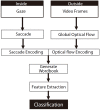Recognition of Activities of Daily Living with Egocentric Vision: A Review
- PMID: 26751452
- PMCID: PMC4732105
- DOI: 10.3390/s16010072
Recognition of Activities of Daily Living with Egocentric Vision: A Review
Abstract
Video-based recognition of activities of daily living (ADLs) is being used in ambient assisted living systems in order to support the independent living of older people. However, current systems based on cameras located in the environment present a number of problems, such as occlusions and a limited field of view. Recently, wearable cameras have begun to be exploited. This paper presents a review of the state of the art of egocentric vision systems for the recognition of ADLs following a hierarchical structure: motion, action and activity levels, where each level provides higher semantic information and involves a longer time frame. The current egocentric vision literature suggests that ADLs recognition is mainly driven by the objects present in the scene, especially those associated with specific tasks. However, although object-based approaches have proven popular, object recognition remains a challenge due to the intra-class variations found in unconstrained scenarios. As a consequence, the performance of current systems is far from satisfactory.
Keywords: activity recognition; ambient assisted living; egocentric vision; wearable cameras.
Figures












References
-
- European Commission (DG ECFIN) and the Economic Policy Committee (AWG) The 2015 Ageing Report: Underlying Assumptions and Projection Methodologies. 2015. [(accessed on 31 December 2015)]. Available online: http://ec.europa.eu/economy_finance/publications/european_economy/2014/p....
-
- Colby S.L., Ortman J.M. Projections of the Size and Composition of the US Population: 2014 to 2060. [(accessed on 31 December 2015)]; Available online: https://www.census.gov/content/dam/Census/library/publications/2015/demo....
-
- European Commission Active Ageing: Special Eurobarometer 378. 2012. [(accessed on 31 December 2015)]. Available online: http://ec.europa.eu/public_opinion/archives/ebs/ebs_378_en.pdf.
-
- BREATHE Consortium BREATHE—Platform for Self-Assessment and Efficient Management for Informal Caregivers. [(accessed on 20 October 2015)]. Available online: http://www.breathe-project.eu.
Publication types
MeSH terms
LinkOut - more resources
Full Text Sources
Other Literature Sources
Research Materials

